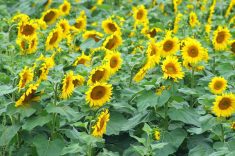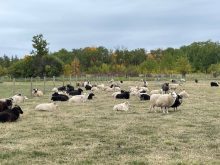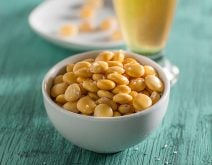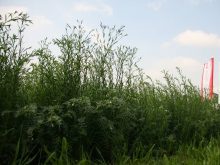When I moved west to the Prairies many moons ago, golden canola fields were the Cinderella crop and flax made up reliable blue oilseed acres. Prairie canola now exceeds 20 million acres, whereas flax, primarily grown in Saskatchewan, hovers at around one million acres (400,000 hectares).
While canola yields have moved from the low 20 bushels per acre or less to the more recent 40 bushels per acre, flax yields have lagged in the very low to middle 20-bushel range with some flax crops yielding up to 35 bushels or more.
Bushel price for flax remains higher than canola, moving in one instance to a 40-dollar high but present prices now remain in the $20- to $25-per-bushel range in the last year or so.
Read Also

Claas brings 1000 Series SP forage harvesters to Canada
In mid-August, Claas unveiled its new line of Jaguar forage harvesters at an event in Visalia, California, deep in the heart of that state’s dairy region.
Flax or linseed goes by the botanic name Linum usitatissimum. It is one of the oldest cultivated crops on record grown for its fibres (straw) and for its grain for food. Records for its cultivation go back tens of thousands of years.
[RELATED] Manitoba Co-operator: Manitoba sisters follow parents’ pioneering ways to innovative plant ‘milk’
Flaxseed and straw production surprisingly have a very large range of usage. The seed may be crushed to produce linseed or health-wise consumed as flax oil. Here are some quick facts on flax:
- Linseed oil is a colourless or yellowish oil used in wood finishing, a pigment binder in oil paints and printing inks, a hardener in window putty and is used in the manufacture of linoleum.
- Linseed meal is a protein-rich feed or food for humans and animals that is available in two basic colours from brown- or yellow-coloured seeds.
- Flax fibres in flax straw are up to three times stronger than cotton fibres. They are naturally smooth and straight. Europeans were very dependent on flax-based cloth (linen) before cotton became popular. Flax straw left after a crop harvest is not recommended as a fodder since it is much too tough for livestock feed and low in nutrition. It can be used as livestock bedding. Flax straw is also used to make cigarette paper and the finest writing paper.
In Asia, flax is an integral part of cooking, both for flavour and its oil. Its omega-3 (alpha-linolenic acid) is considered a key health ingredient and flaxseed is known to be very high in digestible fibres.
Why the reluctance to row flax?
In the last few years, we have seen better weed control products for flax along with the production of superior disease-resistant flax varieties.
Flax has a growing time from seed to harvest of 90 to 120 days, grows 16 to 40 inches tall with tap roots that grow up to three feet into the soil, contrary to its reputation as shallow rooted.
Flax is seeded at a rate of 26 to 52 pounds per acre (a half to one bushel) generally in seven- to 12-inch rows. Seed establishment is anywhere from 150 to 300 plants per square metre (20 to 40 plants per square foot). The average Saskatchewan flax yield is around 20 bushels per acre, whereas in Manitoba and Alberta the yield may be 25 to 30 bushels.
Canada has long been the major exporter and grower of flaxseed at around 600,000 to one million tons, but in recent years Kazakhstan and Russia have both produced as much tonnage of this oilseed.
Soil requirements for flax would be little different than that for canola or wheat, but growers seem to seed flax on what they consider to be their poorer soils and blame it for low yields.
For a 24-bushel crop of flax (around 52 pounds per bushel), the fertility required is around 65 pounds of nitrogen (N), 18 pounds of phosphate (P), 35 pounds of potash (K) and 10 pounds of sulphur (S) for both seed and straw. The actual flax straw, while providing N, P, K and S in the residue, is highly unpalatable as animal feed, fit only for bedding straw.
In the past, flax straw was baled and sold for a variety of purposes since when left on cropland it could cause severe tangling up of equipment. Your next combine should have a straw chopper because the best place for crop residue is chopped up and immediately returned to the cropland. That’s the primary step in sustainable farming.
I will examine flax diseases at a later time, since there are a number of them that can cause significant yield losses. Newer flax varieties show good to excellent disease resistance. Check this out: there is even a new flax variety called CDC Glas. Being of Welsh background, that translated from the Welsh word for blue (that is, Glas), as in Glaslyn, Sask., the village name that translates to blue lake.
I am a firm believer in flax as an excellent health-giving cereal grain. Some 20 years ago, I complained to an Alberta flax grower and client farmer that my knee joints gave me a lot of pain (I played many years of rugby). He told me he had the solution.
Before I left the farm, the farmer gave me a 20-pound bag of flaxseed and said if I ate ground up flax porridge every second day for a month, my knee pain would disappear. He was 100 per cent right. I have no medical explanation, but this works for me and several friends who suffered joint pains.
The flax in ground flaxseed porridge I have for breakfast every second day makes up 60 per cent of the ingredients. The rest of the porridge is sunflower seed, buckwheat, almond, quinoa and poppy seed (ground in a coffee grinder), and a cup or so of water is added to make a light slurry. After heating the watered mix for five minutes, I add a dollop of milk and a tablespoon of maple syrup. This porridge tastes as good as if not better than plain old oatmeal.
To wind up, I must bring attention to our Prairie soil scientists. In all of the literature I have looked up on flax fertility, there is no mention of micronutrients. In the United States, the U.K. and worldwide, flax is one of the most sensitive crops known to low or deficient soil levels of copper and zinc. How do I know? From international research and practical experience.
Back in the 1980s, my colleagues and I were able to show that several farmers in northeastern Alberta had crop failures growing flax on sandy soils. We found out why: these soils were highly deficient in available copper. Adding copper fertilizer resulted in normal flax growth and expected yields.
Next time any agency on the Prairies works on pushing flax yields upwards, please check out the soil’s copper and zinc levels. A colleague of mine boosted flax fertility over the recommended levels on central Alberta cropland. He also added generous amounts of both zinc and copper, resulting in the grower consistently achieving 35 to 40 bushels of flax per acre.
Present day flaxseed prices compete well with canola returns and growing flax gives farmers an additional rotational crop. This is especially important in view of clubroot of canola and aphanomyces root rot of peas, both of which shrink on-farm crop rotation options.
















